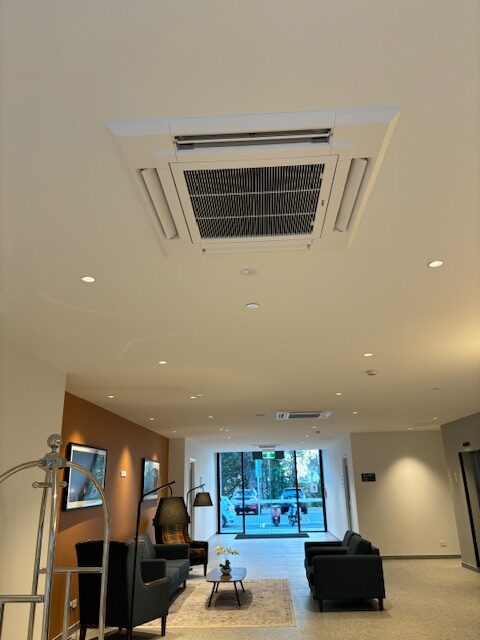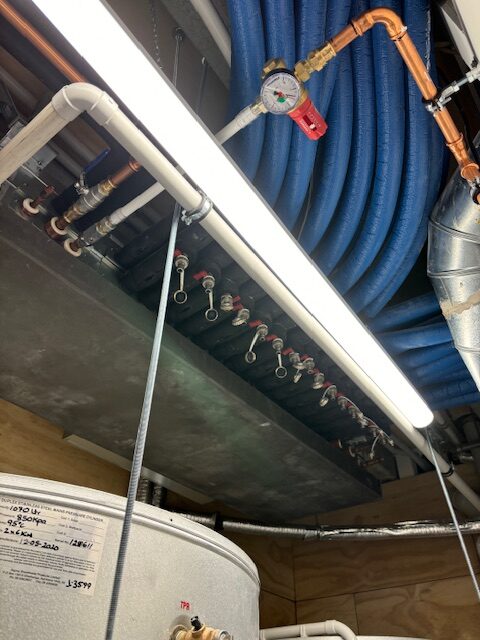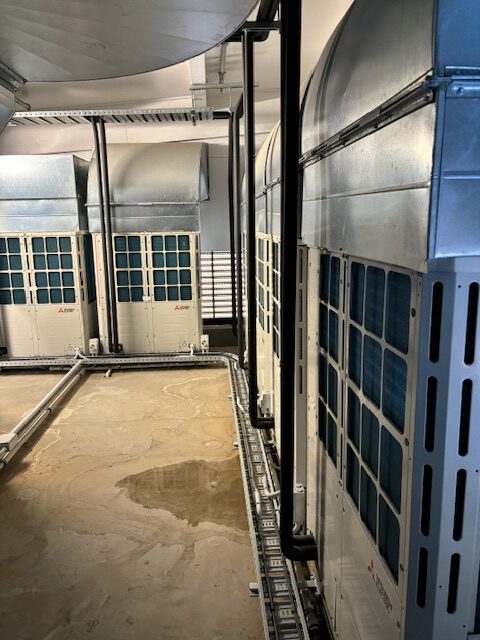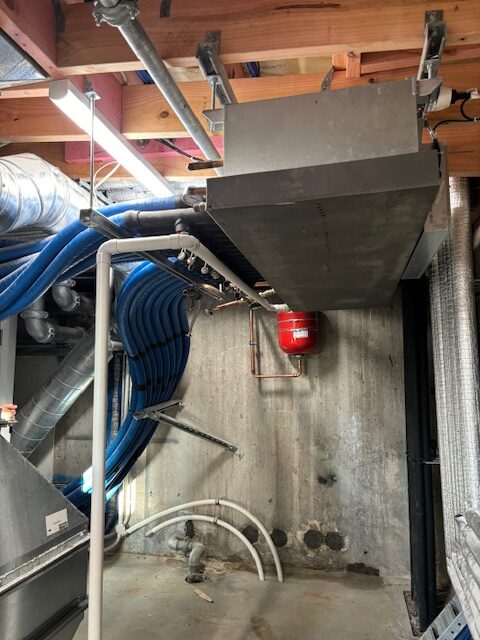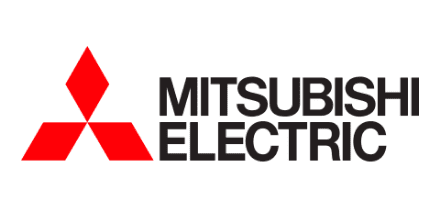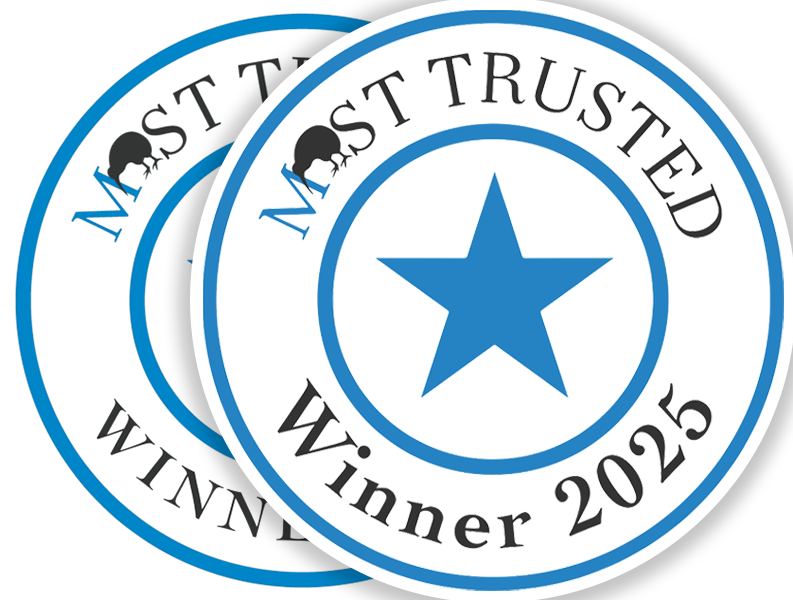Evolving Commercial Landscape: Energy Efficiency and Sustainability in Christchurch
As the demand for environmental responsibility grows, it’s essential to keep on top of your sustainability practices by future-proofing your commercial property. This blog post will explore how integrating a Hybrid Variable Refrigerant Flow (HVRF) system can transform your building into an energy-efficient powerhouse. We will cover the challenges and benefits of HVRF systems, including improved energy efficiency, environmental impact, flexibility, comfort, and increased property value, and discuss how you can get started today with the Mitsubishi Electric Hybrid Variable Refrigerant Flow (HVRF) system.
What Is a Hybrid VRF Air Conditioning System?
A Hybrid Variable Refrigerant Flow (HVRF) system combines the advantages of traditional VRF systems with advanced chiller technology. By allowing simultaneous heating and cooling within a building, HVRF systems use water as a heat transfer medium, enhancing efficiency and flexibility. Unlike conventional HVAC systems reliant solely on refrigerant lines, HVRF systems incorporate water lines, making them safer and more effective.
The Benefits of HVRF Systems for Commercial Buildings
- Energy Efficiency and Cost Savings
One of the most compelling reasons to switch to an HVRF system is its superior energy efficiency. Traditional HVAC systems often waste energy by heating and cooling different areas independently. In contrast, HVRF systems balance these needs, resulting in significant cost savings on energy bills. - Environmental Impact
With increasing concerns about climate change, reducing your building’s carbon footprint is crucial. HVRF systems use less energy and can significantly decrease greenhouse gas emissions. By upgrading, you not only save money but also contribute to a more sustainable future. - Flexibility and Comfort
HVRF systems allow for heating and cooling in different zones simultaneously, ensuring greater comfort for occupants. Whether in a multi-tenant office or a hotel, individual zones can be adjusted to meet specific needs, enhancing comfort without sacrificing efficiency. - Improved Building Value
Modern, energy-efficient systems increase property value. Prospective buyers and tenants increasingly seek buildings with sustainable and cost-effective solutions. An HVRF upgrade can make your property more attractive in a competitive market.
How HVRF Systems Improve Energy Efficiency
HVRF systems utilise water lines for part of the heat exchange process, reducing reliance on high-pressure refrigerant lines. This dual medium approach enables efficient heat transfer, managing cooling and heating needs without additional energy consumption. For instance, if one area requires cooling while another needs heating, the HVRF system efficiently handles this, optimising energy use.
Case Study:
We recently upgraded a mid-sized office building in central Christchurch transitioned from a conventional HVAC system to a Mitsubishi Electric HVRF system due to high operating costs and temperature inconsistencies.
Results:
- Energy Consumption: 30% reduction in energy usage within the first year.
- Occupant Satisfaction: Complaints about temperature inconsistencies dropped by 50%.
- Maintenance Costs: Decreased routine maintenance expenses due to improved system reliability and fewer mechanical issues.
- Safety: Enhanced overall building safety through reduced use of high-pressure refrigerant lines and increased use of water lines, with no reported leaks or hazardous incidents.
This case study demonstrates the significant benefits of upgrading to an HVRF system, showcasing that the initial investment leads to both immediate savings and long-term value.
Challenges and Considerations for Installation
Installing HVRF systems in existing buildings can pose challenges, such as the need for ductwork retrofitting and the potential for disruptions during installation. However, HVRF systems, such as the Mitsubishi Electric HVRF system, are designed for seamless integration, minimising downtime and ensuring a smoother transition.
The Role of Advanced Technology
Advanced technology enhances the operation and management of HVRF systems. Equipped with intuitive controls and monitoring capabilities, these systems allow for precise temperature regulation and efficient energy use. Mitsubishi Electric provides comprehensive support and training maintenance staff and managers to ensure optimal performance of their systems.
Conclusion
- Upgrading to a Mitsubishi Electric HVRF system is a strategic choice for commercial building owners in Christchurch, aiming to future-proof their properties.
- HVRF systems offer unmatched energy efficiency, flexibility, comfort, significant cost savings, and environmental benefits.
- Embracing this technology is not just an upgrade; it’s an investment in your building’s future, ensuring competitiveness, compliance, and comfort for years to come.
If you’re considering an upgrade for your commercial building’s HVAC system, make sure to consult with HVAC professionals, assess your current system’s performance, and calculate potential savings and benefits. Making an informed decision now can pave the way for a more sustainable and efficient future for your building.



